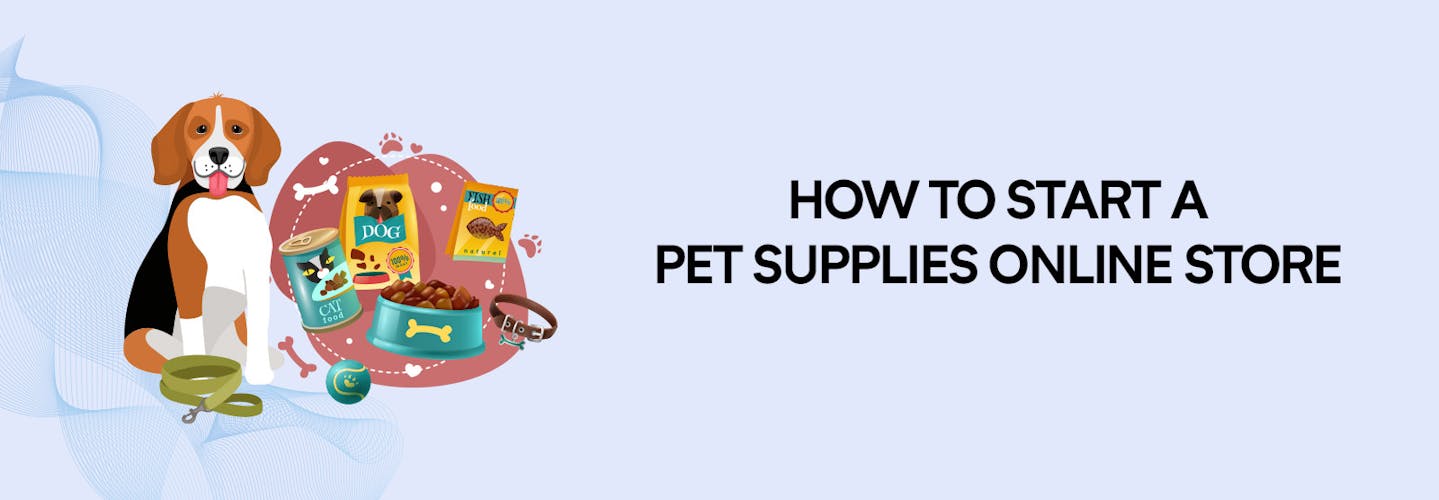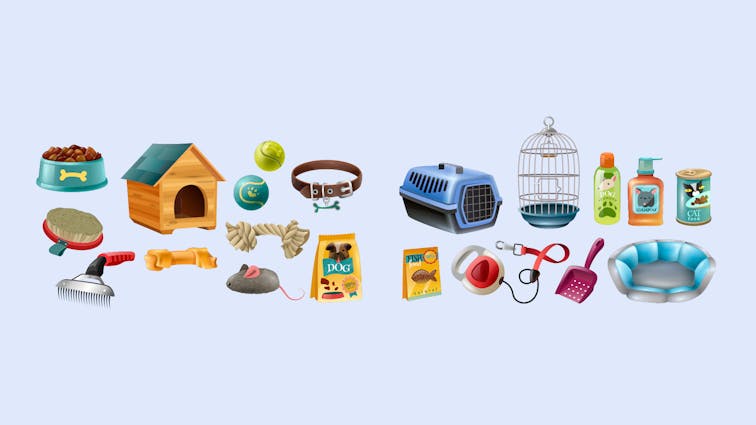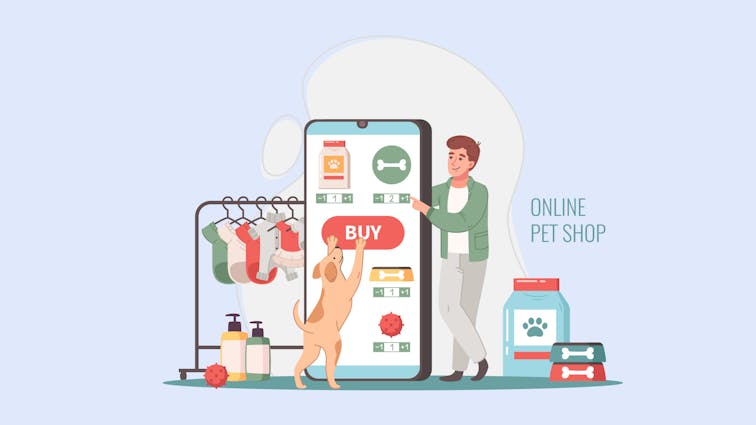
How to start an online pet supply business [2025]
In today’s digital age, starting an online business is an exciting endeavor for many entrepreneurs, and the pet supplies industry is no exception.
Knowing How to Start a Pet Supplies Online Store can be a lucrative business opportunity, as pet owners are always looking for quality products for their furry friends.
In this guide, we will walk you through the steps to set up your online pet supplies store and provide some tips for success.
How to start an online pet supplies store: a step-by-step guide
Here’s how you can start a pet supplies store online quickly:
- Identify your niche and target market
- Create a business plan
- Register your business
- Source your products
- Building Your Online Store
- Inventory Management and Order Fulfillment
- Marketing and Promoting Your Online Pet Store
- Providing Excellent Customer Service
- Monitor and optimize your store’s performance
1. Identify your niche and target market
Identifying your niche and target market is a critical first step in building a successful business or brand.
It helps you understand your potential customers’ needs, preferences, and problems so that you can tailor your offerings and marketing strategies accordingly.
1. Defining Your Niche
A niche is a specialized segment within a larger market you’ll focus on serving. By narrowing your focus, you can become an expert in that area and stand out among competitors. To define your niche, consider the following:
A. Passion and expertise:
Choose a field in which you are genuinely interested and have knowledge or skill. This will make becoming an expert in your niche more enjoyable and accessible.
B. Customer needs and preferences:
Identify your target audience’s specific needs, preferences, and pain points. This will allow you to offer customized products and services that cater to their unique requirements.
C. Market demand and competition:
Research the need for your chosen niche and analyze the competition within that segment. Aim to find a balance between a place in order but not oversaturated with competitors.
D. Profitability:
Ensure that your chosen niche has the potential to generate revenue and long-term growth.
2. Identifying Your Target Market
Your target market is the customers you aim to attract and serve with your products and services. To identify your target market, consider the following factors:
A. Demographics:
Analyze the age, gender, income levels, education, and other demographic factors that characterize your potential customers. This will help you tailor your marketing messages and product offerings to suit their needs.
B. Psychographics:
Understand the attitudes, values, interests, and lifestyle preferences of your target audience. This information can be invaluable in creating marketing campaigns that resonate with your customers.
C. Geographic location:
Determine where your potential customers are located, whether they’re in a specific city, region, or country. This will help you focus your marketing efforts and select the most relevant distribution channels.
D. Buying habits:
Analyze how and when your target market makes purchasing decisions, their preferred product channels, and any other relevant buying trends.
This can help you optimize your sales process and provide a better shopping experience for your customers.
3. Segmentation
Once you have identified your niche and target market, you can further segment your audience into smaller, more specific groups.
This can help you create personalized marketing campaigns and cater to the unique needs of each segment. Consider segmenting your customers based on:
A. Customer behavior:
Segment your customers based on their purchasing patterns, frequency of purchases, and product preferences.
B. Customer needs and preferences:
Group customers together who share similar needs, preferences, or pain points, allowing you to cater your offerings more effectively to each group.
C. Price sensitivity:
Identify customers who are more price-sensitive, and tailor your offerings and promotions to fit their budget.
D. Loyalty:
Group your customers based on their loyalty to your brand, such as first-time buyers, repeat customers, and brand advocates. This enables you to create targeted campaigns and incentives to reward and retain loyal customers.

2. Creating a Business Plan
After identifying your niche, target market, and audience segmentation, the next step is to develop a solid business plan.
Your business plan should outline your goals, strategies, and financial projections. Consider including the following sections in your plan:
A. Executive summary: Provide a brief overview of your business, including your mission statement, vision, and objectives.
B. Company description: Describe your business’s structure, ownership, and history (if applicable).
C. Market analysis: Summarize the market research you conducted on your niche and target market, including key trends, customer needs, and competitive landscape.
D. Products and services: Detail your product offerings and services, highlighting their unique features, benefits, and pricing strategies.
E. Marketing and sales strategies: Outline your marketing plan, including target audience, positioning, promotional tactics, and sales channels.
F. Operations: Describe your operational processes, such as inventory management, order fulfillment, customer service, and any partnerships or suppliers you plan to work with.
G. Management and organization: Explain your business’s organizational structure, including key roles and responsibilities, and any relevant experience or expertise of your team members.
H. Financial projections: Provide a forecast of your business’s financial performance, including sales, expenses, and profitability.
I. Risks and challenges: Identify potential obstacles and challenges your business may face and strategies for overcoming them.
J. Appendices: Include any additional information or documents that support your business plan, such as market research data, product samples, or sales projections.
3.Register your business
Once you have identified your niche, target market, and developed a solid business plan, it’s important to register your online pet supply business.
This involves choosing a unique and memorable name for your business and registering it with the relevant local and state authorities.
Depending on the structure and location of your business, you may need to obtain permits, licenses, and tax identification numbers. It’s crucial to comply with all legal requirements to avoid any potential legal issues in the future.
Hiring a business attorney or accountant to assist with the registration process can ensure that you have all the necessary documentation and are complying with all applicable laws and regulations. This can help you avoid costly mistakes and ensure that your business is set up for success.
Remember, registering your business is crucial to establishing a legitimate and professional online presence.
By taking the necessary legal steps, you can protect your business and ensure that you operate securely and sustainably.

4. Source your products
Once you have established your niche, target market, and business plan, sourcing high-quality products catering to your customers’ needs and preferences is important. Consider the following tips for finding reliable suppliers and manufacturers:
A. Research potential suppliers:
Conduct thorough research to identify potential suppliers and manufacturers that offer pet supplies within your chosen niche.
Look for companies with a proven track record of delivering high-quality products and excellent customer service.
Consider attending industry trade shows or reaching out to other online pet store owners for recommendations.
B. Negotiate deals:
Once you have identified potential suppliers, negotiate deals with them to ensure you get the best prices, terms, and delivery options.
Consider ordering in bulk to take advantage of volume discounts and reduce shipping costs.
C. Offer a mix of well-known and unique products:
Balance your product offerings by including both well-known, established brands and unique, lesser-known products that differentiate your store from competitors.
This can help you appeal to a wider audience and provide a unique shopping experience for your customers.
D. Focus on quality and safety:
Ensure that all of your products meet high standards of quality and safety, as pet owners are often willing to pay a premium for safe and reliable products.
Consider conducting product testing and research to ensure that your products meet your customers’ expectations.
E. Establish strong relationships with suppliers:
Maintain open communication with your suppliers, building a strong relationship with them.
This can help you receive preferential treatment, such as priority shipping and access to new products or exclusive deals.
F. Consider dropshipping:
If managing inventory and order fulfillment in-house is not feasible, consider using dropshipping or partnering with a third-party fulfillment service.
This can help reduce overhead costs, minimize storage space requirements, and free up valuable time to focus on other aspects of your business.
G. Ensure compliance with regulations:
Ensure that all your products comply with relevant regulations and safety standards, such as those set by the FDA or USDA.
This can help prevent any legal issues or product recalls in the future.

5. Building Your Online Store
Once you have a clear business plan, you can begin setting up your online pet store. Consider the following steps to establish a strong online presence:
A. Choose a domain name:
Select a memorable and easy-to-spell domain name that reflects your brand and niche.
B. Select an e-commerce platform:
Research and choose an e-commerce platform that offers the features, functionality, and customization options you need to create a user-friendly and visually appealing online store.
Popular platforms include Aasaan, Shopify, WooCommerce, Magento, and BigCommerce.
Creating an Attractive and User-Friendly Website
Your online pet store’s website should be visually appealing, easy to navigate, and optimized for desktop and mobile devices. Consider the following elements when designing your website:
- High-quality product images and descriptions: Showcase your products with clear, high-resolution images and provide detailed, accurate product descriptions to help customers make informed purchasing decisions.
- Easy navigation and search functionality: Organize your products into intuitive categories and provide a search bar to help customers quickly find what they want. Additionally, implement filters based on product attributes, such as size, color, or brand, to further assist customers in their search.
- Responsive design: Ensure your website is optimized for various devices, including desktop computers, laptops, tablets, and smartphones, to provide a seamless user experience across all platforms.
- Simple and secure checkout process: Streamline the checkout process by minimizing the number of steps and offering a variety of payment options, such as credit cards, PayPal, and other digital wallets. Prioritize security using SSL encryption and comply with data protection regulations to protect customer information.
- Helpful content and resources: Create a blog, FAQ section, or resource center to provide valuable information and resources related to pet care and products. This can help establish your store as a trusted authority in the pet industry and encourage customer loyalty.
- Customer reviews and testimonials: Encourage and display customer reviews and testimonials on your product pages and website. This can help build trust and credibility with potential customers and increase their likelihood of purchasing.
C. Design your website:
Create a professional and visually appealing website that showcases your products and services, conveys your brand’s personality, and provides a seamless shopping experience for your customers.
D. Optimize for mobile:
Ensure that your website is mobile-responsive, as more and more consumers shop on their smartphones and tablets. This will help you cater to a wider audience and improve conversion rates.
F. Set up payment and shipping options:
Integrate a secure payment gateway and provide multiple payment options for your customers. Also, set up shipping options, rates, and delivery times based on your target market’s preferences and geographic location.
G. Create product descriptions and images:
Write clear, concise, and engaging product descriptions that highlight the features and benefits of your products.
Include high-quality images that showcase your products from different angles and any additional information such as size charts or care instructions.
H. Implement SEO best practices:
Optimize your website for search engines by incorporating relevant keywords, meta tags, and alt tags for images. This will help improve your website’s visibility and attract more organic traffic.
I. Develop a content strategy:
Create valuable and engaging content, such as blog articles, videos, and social media posts, that educates and entertains your audience while showcasing your expertise in the pet industry.
J. Establish a social media presence:
Set up accounts on popular social media platforms like Facebook, Instagram, Twitter, and Pinterest. Share updates, promotions, and engaging content with your followers to build brand awareness and foster a sense of community.
K. Launch email marketing campaigns:
Collect customer email addresses and send targeted campaigns promoting your products, offers, and valuable content. This helps to maintain customer engagement and drive repeat sales.
L. Monitor and analyze performance:
Track your website’s performance using analytics tools like Google Analytics to gain insights on your visitors’ behavior, traffic sources, and conversion rates. Use this information to make data-driven decisions and improve your online store’s performance.

6. Inventory Management and Order Fulfillment
Efficiently managing your inventory and ensuring timely order fulfillment is crucial for the smooth operation of your online pet store. Following these best practices can help in achieving this:
- Choose the right inventory management system: Implement a robust inventory management software that tracks stock levels, allows for easy updates, and provides alerts when stock levels are low. This will help prevent stockouts and overselling issues.
- Sync inventory across multiple channels: If you sell on different platforms or in physical stores, ensure your inventory is synced across all channels to avoid discrepancies and ensure accurate stock levels. This can also help you manage your inventory more effectively and reduce the risk of overselling.
- Set reorder points and safety stock levels: Establish reorder points to automatically replenish stock when it reaches a certain level, ensuring you always have enough products to meet customer demand. Also, maintain safety stock levels to account for any unexpected fluctuations in demand or supply chain disruptions.
- Implement a reliable order fulfillment process: Streamline your order fulfillment process by investing in a reliable shipping partner, utilizing efficient packaging solutions, and establishing clear shipping policies. This can help reduce shipping errors, minimize delays, and ensure that your customers receive their orders promptly.
- Use dropshipping or third-party fulfillment services: If managing inventory and order fulfillment in-house is not feasible, consider using dropshipping or partnering with a third-party fulfillment service. This can help reduce overhead costs, minimize storage space requirements, and free up valuable time to focus on other aspects of your business.
- Regularly audit your inventory: Conduct periodic inventory audits to ensure stock levels are accurate and to identify any discrepancies or potential issues. This can help you maintain accurate inventory records and prevent costly mistakes.
- Optimize your warehouse layout: Organize your warehouse or storage space to maximize efficiency and minimize the time it takes to pick, pack, and ship orders. This can help improve order fulfillment efficiency and reduce the likelihood of errors.
- Analyze and forecast demand: Regularly review your sales data to identify trends and anticipate future product demand. This can help you make more informed decisions regarding ordering and stocking inventory, preventing stockouts or overstocking.
- Monitor and manage supplier relationships: Maintain open communication with your suppliers, ensuring that they meet your expectations in terms of product quality, delivery times, and responsiveness. Establishing strong relationships with reliable suppliers can help ensure a steady inventory flow and minimize potential disruptions.
7. Marketing and Promoting Your Online Pet Store
Effectively marketing your online pet store is essential for attracting and retaining new customers. Consider implementing these strategies to promote your business:
A. Optimize your website for search engines:
Implement SEO (Search Engine Optimization) best practices to improve your website’s visibility on search engines like Google.
This includes using relevant keywords, optimizing meta tags, and creating high-quality, engaging content. A higher search engine ranking can increase organic traffic and potential customers.
B.Utilize social media advertising:
Run targeted ads on social media platforms such as Facebook, Instagram, and Pinterest to reach a wider audience and attract potential customers.
Create visually appealing ad creatives and tailor your messaging to your target demographic.
C. Collaborate with influencers:
Partner with pet influencers and bloggers to showcase your products and reach a larger audience.
Influencer marketing can help build credibility for your brand and drive traffic to your website.
Offer influencers exclusive discounts or free products in exchange for their promotion of your online pet store.
D. Create engaging content:
Produce high-quality, informative, and engaging content for your website, blog, and social media channels.
Share helpful tips, pet care advice, and product-related information to position your brand as a trusted authority in the pet industry.
This can help attract new customers and keep existing ones engaged.
E. Run promotions and sales:
Offer limited-time promotions, discounts, and sales events to attract new customers and encourage repeat purchases.
Be strategic with your promotions, tying them to holidays, seasonal events, or product launches to maximize their impact.
F. Use email marketing:
Build and maintain an email list of customers and potential customers.
Send regular newsletters, promotional emails, and product updates to keep your audience informed and engaged.
Personalize your email campaigns to make them more relevant and appealing to your subscribers.
G. Participate in online forums and communities:
Become an active member of online pet forums, discussion groups, and communities.
Share your expertise, answer questions, and engage with fellow pet lovers to build trust and credibility for your brand.
Be sure not to overly promote your products; instead, focus on providing valuable information and fostering genuine connections.
H. Implement a loyalty program:
Reward your most loyal customers with a loyalty program, offering discounts, exclusive deals, or free products for repeat purchases.
This can help encourage customer retention and promote long-term relationships.
I.Use retargeting and remarketing strategies:
Implement retargeting and remarketing campaigns to re-engage customers who have visited your website or interacted with your brand but did not purchase.
Utilize cookies and tracking pixels to deliver targeted ads to these potential customers, reminding them of your products and encouraging them to complete their purchases.
J.Leverage customer reviews and testimonials:
Encourage satisfied customers to leave reviews and testimonials on your website and third-party review platforms.
Positive reviews can help build trust and credibility for your brand, ultimately leading to increased sales and customer loyalty.
8. Providing Excellent Customer Service
Providing exceptional customer service is crucial for the success and growth of your online pet store. Keep these tips in mind to ensure your customers have a positive experience shopping with you:
A. Offer multiple communication channels:
Provide customers with various ways to get in touch with your customer support team, such as email, phone, live chat, and social media.
This enables customers to reach out using their preferred method and can lead to faster resolutions.
B. Respond promptly and professionally:
Ensure that your customer support team responds promptly and professionally to inquiries and complaints.
Quick, helpful responses can often turn a negative situation into a positive one, demonstrating your commitment to excellent service.
C. Provide clear and concise information:
Make sure that your website and customer support team provide accurate, up-to-date information about your products and services, shipping and return policies, and any other frequently asked questions.
D. Train your customer support team:
Invest in training your customer support team to ensure they have the knowledge and skills to assist customers effectively.
Provide them with the resources and tools to answer questions and resolve issues efficiently.
E. Personalize your customer interactions:
Treat each customer individually and tailor your responses to their specific needs and concerns.
Personalized interactions can make customers feel valued and create a more positive shopping experience.
F. Implement customer feedback:
Actively seek customer feedback and use it to improve your products, services, and overall customer experience.
Acknowledge and address any customer issues or concerns, demonstrating your commitment to their satisfaction.
G. Offer flexible return and exchange policies:
Develop fair and exchange policies that accommodate your customers. Communicate these policies on your website and ensure your customer support team is well-versed in handling such requests.
A flexible and hassle-free return process can instill trust and confidence in your brand.
H. Go the extra mile:
Surprise and delight your customers by exceeding their expectations whenever possible.
This can include offering free samples, sending personalized thank you notes, or providing unexpected discounts.
These gestures can create a memorable experience and encourage customer loyalty.
I. Measure customer satisfaction:
Regularly track and analyze customer satisfaction metrics, such as Net Promoter Score (NPS) or Customer Satisfaction Score (CSAT), to gain insights into your customers’ experiences and identify areas for improvement.
J. Continuously improve:
Use the feedback and insights gathered from customers and your customer satisfaction metrics to refine and improve your customer service processes, policies, and strategies.
Strive for constant growth and development, ensuring your online pet store remains a leader in providing excellent customer service.
9: Monitor and optimize your store’s performance
Regularly reviewing your online pet supply store’s performance is crucial for success. This includes analyzing sales data, website traffic, and customer feedback.
By understanding how your store is performing, you can identify areas for improvement and make necessary adjustments. Here are some ways to monitor and optimize your store’s performance:
- **Utilize analytics tools:**Use software like Google Analytics or other e-commerce analytics tools to track website traffic, conversion rates, and user behavior. This data will help you understand where your customers are coming from, what they are looking for, and how well your products sell.
- Customer surveys: Conduct customer surveys to collect feedback on your product offerings , website design, customer service, and overall shopping experience. Use this feedback to identify areas for improvement and implement changes accordingly.
- **A/B testing:**Implement A/B testing on various elements of your website, such as product descriptions, images, and calls-to-action. Comparing the performance of these variations can help you determine which changes are most effective in improving conversion rates and user engagement.
- **Monitor sales data:**Review sales data regularly to identify trends, top-selling products, and potential inventory issues. This information can guide you in making more informed decisions about product selection, pricing strategies, and promotions.
- Track customer reviews and interactions: Keep a close eye on customer reviews and interactions on your website, social media, and other platforms. Respond to positive and negative feedback, address concerns, and use this information to improve your customer service and overall store experience.
- **Invest in search engine optimization (SEO):**Optimize your website and product listings to rank higher on search engine results pages. This includes using relevant keywords, writing high-quality content, and ensuring a fast, mobile-friendly website.
- **Adjust marketing campaigns:**Regularly evaluate the performance of your marketing campaigns, such as social media advertising or email newsletters. Adjust your strategies based on what works best for your target audience and budget.
- Monitor competitors: Keep an eye on your competitors’ pricing, product offerings, and marketing strategies to stay competitive. Look for ways to differentiate your online pet store and offer unique value propositions to your customers.
- **Continuously update and refresh your website:**Regularly update your website with new product releases, promotional offers, and engaging content such as blog posts or articles to keep customers engaged and interested.
- Encourage customer loyalty:Implement loyalty programs, special offers, or personalized promotions to reward returning customers and encourage them to continue shopping at your online pet store. This can help boost customer retention and increase long-term revenue.
By continuously monitoring and optimizing your online pet supply store’s performance, you can make data-driven decisions to help your business thrive in the competitive pet industry.
Remember to stay adaptable, learn from your customer feedback, and be open to experimenting with new strategies and ideas.
As you grow and evolve, your online pet store will become a trusted destination for pet owners seeking high-quality products and exceptional customer service.
Conclusion:
Starting an online pet supply store can be rewarding for pet lovers and entrepreneurs.
By following the steps outlined above, researching the market, sourcing products from reliable suppliers, creating an engaaging website, and implementing effective marketing strategies, you can build a successful online business in the pet industry.
Remember to be patient, persistent, and always keep your customers’ needs and preferences at the heart of your operations. With hard work and dedication, your online pet store can flourish and help you establish a strong presence in the growing pet market.
FAQ’S:
1. Is owning a pet store profitable?
Yes, owning a pet store can be profitable. The pet industry is a multi-billion dollar industry and the demand for pet-related products and services continues to grow. However, profitability can vary depending on factors such as location, competition, and the types of products and services offered.
2. What are the most effective marketing strategies for a new online pet supply business?
Establish a strong online presence through search engine optimization (SEO) and social media marketing. Offer competitive pricing, quality products, and exceptional customer service to build a loyal customer base.
3. What kind of products can I sell?
You can sell a variety of pet-related products such as food, treats, toys, grooming supplies, accessories, and healthcare products. You may also consider offering unique or niche products to differentiate yourself from competitors.
4. Do online pet shops offer pet supplies as well?
Yes, most online pet shops offer a wide range of pet supplies, including food, toys, grooming products, and accessories. Some even offer personalized recommendations based on your pet’s breed and needs.
5. Can I return a pet if I’m not satisfied with my purchase?
Most online pet shops have a return policy in place for pets, but it’s important to read the policy carefully before making a purchase. Generally, returns are only accepted for health reasons or if the pet arrives in poor condition. It’s important to be prepared for the responsibility of owning a pet before making a purchase.








